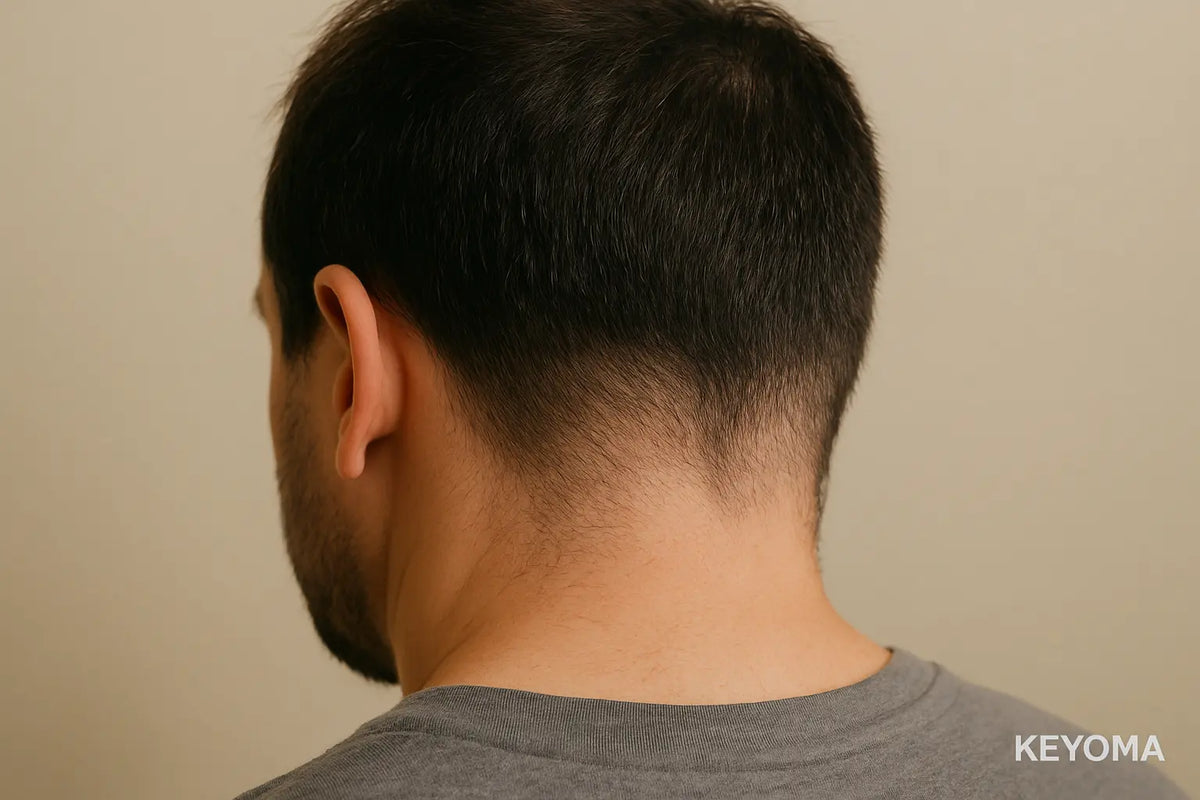In this article
Most people only ever hear about hair loss that starts from the top, such as the receding temples or the thinning crown. But there’s another kind that quietly works its way up from the neck instead, one that even seasoned hair enthusiasts rarely talk about: retrograde alopecia.
It’s a lesser-known form of pattern hair loss that begins at the nape and moves upward, thinning the very areas we usually think are safe from balding. Because it progresses slowly, it often goes unnoticed until the hairline near the neck or sides starts to look sparse.
In this guide, we’ll talk about what makes retrograde alopecia so unique, the signs that set it apart from regular pattern baldness, and the best treatment and care options to help you manage it early.
What is Retrograde Alopecia?

Retrograde alopecia is a specific form of hair loss that starts from the nape of the neck and moves upward. It creates a gradual thinning or recession along the back and sides of the scalp, sometimes forming a noticeable U-shaped pattern.
This type of alopecia is considered a subtype of androgenetic alopecia, often showing up in men during their 20s to 40s, but it’s frequently overlooked until the hairline at the nape becomes visibly thin.
But what makes retrograde alopecia particularly concerning? The area at the nape and sides—also called the 'permanent zone'—is typically resistant to thinning. For that reason, it's often used as the donor area for hair transplants.
That means, when that zone starts receding, future treatment options become limited. You’re left with fewer viable donor hairs, and in some cases, it becomes difficult to achieve a natural-looking result during restoration.
Unlike the usual male pattern baldness that starts at the crown or temples, retrograde alopecia moves in the opposite direction, starting low and progressing upward.
Retrograde Alopecia Causes
Hormonal Sensitivity
Hormonal sensitivity refers to how hair follicles react to androgens, especially dihydrotestosterone (DHT). This sensitivity triggers a process called miniaturization, where the affected follicles shrink over time and produce shorter, thinner hairs until they stop growing entirely.
Genetics
If your family has a history of thinning around the neckline or sides of the scalp, you're likely to develop the same pattern as well.
In this case, the focus shifts toward slowing down the thinning by doubling down on lifestyle habits, like improving diet, managing stress, and maintaining scalp health, rather than expecting to stop it entirely.
Autoimmune Disorders
Autoimmune disorders happen when the body's immune system mistakenly attacks its own tissues, including healthy hair follicles.
In some cases, this immune response targets follicles in the lower scalp or sides, disrupting the normal hair cycle and causing inflammation. Over time, this can lead to localized follicle damage and a form of hair loss that resembles retrograde alopecia.
Tight Hairstyles
Tight ponytails, braids, cornrows, or buns are the kinds of hairstyles that cause repeated tension and stress on the hair follicles near the hairline, nape, and sides.
If this pulling continues, it can trigger thinning that mimics the same pattern seen in retrograde alopecia, especially in people already predisposed to follicle weakness.
Scalp Infections
Scalp infections are caused by bacteria, fungi, or viruses that invade the skin on the scalp. Common examples include tinea capitis (a fungal infection), folliculitis, and untreated seborrheic dermatitis.
When infections are left unchecked, they can trigger inflammation that damages the hair follicles. If this damage happens repeatedly or in areas like the nape and sides, it can lead to patchy thinning or scarring that follows a retrograde pattern.
Stress
When stress becomes chronic, it disrupts hormone balance and pushes more follicles into the resting (telogen) phase.
In people already prone to hair loss, this shift accelerates thinning in vulnerable zones, including the lower scalp. Over time, it can exaggerate the retrograde pattern, even if the hair eventually regrows in some cases.
Retrograde Alopecia Signs & Symptoms
How do you tell if you have retrograde alopecia? The most accurate way is through a proper diagnosis, which we’ll cover later. But to get a sense of whether your current hair changes match the pattern, these early signs and symptoms can offer a quick reference.
-
Thinning at the nape of the neck: Hair looks noticeably finer or patchier at the lower back of the scalp.
-
U-shaped recession pattern: Hair loss creeps upward in a curved band that spans the back of the head from ear to ear.
-
Widening gap between back hairline and crown: The distance from the nape to the crown seems to grow over time.
-
Miniaturized hairs at the neckline: Strands appear shorter, finer, and less pigmented near the bottom edge of the scalp.
-
Loss of density on the sides: Hair near the ears looks flatter, weaker, or less full than before.
-
More visible scalp when fading or shaving: Barbers or stylists may point out patchy areas that weren’t there before.
-
No matching thinning at the crown or temples (initially): Loss is concentrated low before moving upward.
Diagnosing Retrograde Alopecia
While the signs and symptoms listed earlier can help you spot possible early changes, they aren’t enough to confirm retrograde alopecia. The only way to know for sure is through a clinical diagnosis by a qualified professional, usually a dermatologist or trichologist.
Here’s what to expect during the diagnostic process:
-
Scalp examination: Your doctor will inspect the nape and sides of your scalp for signs of miniaturization, inflammation, or scarring.
-
Trichoscopy (scalp imaging): A handheld device called a dermatoscope magnifies your follicles to detect early changes in hair shaft thickness or follicle health that aren’t visible to the naked eye.
-
Pull test: They may gently tug on strands in the affected area to see how easily hairs come out, which helps determine active shedding.
-
Photograph monitoring: Your provider may take reference photos to compare progression over time.
-
Scalp biopsy: In unclear or severe cases, a small skin sample may be taken to examine the follicles under a microscope. This helps rule out autoimmune or scarring alopecia conditions.
-
Blood tests: Sometimes ordered to rule out underlying triggers like thyroid issues, nutrient deficiencies, or hormonal imbalances.
Treatments for Retrograde Alopecia
How do you fix retrograde alopecia? It depends on what’s causing it and how early it’s caught. While there’s no single formula for a cure, several treatments can slow the progression, strengthen remaining hair, and in some cases, even restore lost density.
Below are the most common retrograde alopecia treatment options your dermatologist may recommend:
Topical Minoxidil
Minoxidil works by prolonging the growth (anagen) phase of hair follicles and increasing blood flow to the scalp. For retrograde alopecia, it may help preserve hair density at the nape and sides, especially if caught early before miniaturization becomes severe.
Oral Finasteride (and other DHT blockers)
Finasteride reduces levels of DHT—the hormone linked to follicle shrinking in androgenetic hair loss. Since retrograde alopecia is often DHT-related, this medication helps by slowing or halting further recession along the lower scalp.
It’s typically prescribed for men, and alternatives like dutasteride or topical finasteride may also be discussed.
Low-Level Laser Therapy (LLLT)
This non-invasive option uses light energy to stimulate follicles and reduce inflammation. LLLT has been shown in clinical studies to increase hair density in people with androgenetic alopecia. When used consistently, it may help support weakened follicles in retrograde zones.
Platelet-Rich Plasma (PRP)
PRP therapy involves drawing a small amount of your blood, concentrating the platelets, and injecting them into thinning areas. These platelets contain growth factors that help repair follicle damage and improve hair thickness. PRP may be more effective when paired with other treatments like minoxidil or finasteride.
Hair Transplant Surgery
This is a great option, but with one big caveat: if the donor zone is also affected by retrograde alopecia, you’ll have fewer stable follicles to work with.
In those cases, surgeons may recommend smaller sessions or alternative techniques like body hair transplants. A proper diagnosis and mapping are critical before considering this route.
Anti-Inflammatory Treatments
If retrograde alopecia is linked to inflammation or autoimmune activity, your doctor may prescribe corticosteroid injections, topical steroids, or immunomodulators. These aim to reduce immune-related damage to follicles and preserve existing hair.
How to Prevent Retrograde Alopecia
Genetics is one of the biggest factors behind retrograde alopecia, and that’s also true for other types of pattern hair loss. But just because something runs in your family doesn’t mean you’re helpless against it.
Even if you’re genetically predisposed, there are still steps you can take to delay its onset or slow down its progression. These habits won’t rewrite your DNA, but they can help keep your follicles healthier for longer.
Prioritize Scalp Health
Wash regularly with a gentle, sulfate-free shampoo to prevent buildup and irritation. If your scalp feels dry, flaky, or inflamed, treat it early with soothing ingredients or medicated shampoos as needed.
Use Nourishing Oils
Massaging nourishing oils into your scalp helps improve circulation and keep follicles hydrated, which in turn supports a healthy scalp barrier and strengthens your strands from the root.
Some of the best options include coconut and jojoba oil, both known for their ability to moisturize without clogging pores.
Personally, I recommend rosemary-infused blends, since studies have shown that rosemary oil can perform similarly to 2% minoxidil in promoting growth.
Wear Loose Hairstyles
Tight ponytails, braids, or low fades put unnecessary tension on areas already prone to retrograde thinning. You can check out my previous guide on low-tension hairstyles for ideas that protect your edges while still letting your scalp breathe and your hairline recover.
Improve Your Diet
Without the right nutrients, hair follicles become more vulnerable to hormonal shifts, inflammation, and miniaturization, all of which can speed up retrograde alopecia if you’re already at risk.
Focus on nutrient-dense foods that support follicle strength:
-
Protein: eggs, fish, legumes
-
Iron and zinc: spinach, pumpkin seeds, red meat (in moderation)
-
Omega-3s: walnuts, salmon, chia seeds
-
Vitamin D and biotin: mushrooms, eggs, fortified cereals
At the same time, avoid excess processed sugar, trans fats, and alcohol. All these forbidden foods can worsen inflammation, disrupt hormone balance, and interfere with your body’s natural repair cycles.
Get Quality Sleep
During sleep, your body restores tissue and regulates hormones, including those hormones tied to hair growth. Poor or inconsistent sleep, on the other hand, can push follicles into the resting phase too early.
Aim for 7–9 hours of quality rest each night. Wearing sleep masks and using blockout curtains and white-noise machines can all help improve sleep quality
Reduce Chronic Stress
Chronic stress increases the body’s cortisol levels, which disrupts the normal hair growth cycle. Over time, this can accelerate thinning in those regions and make early-stage hair loss progress faster than it would otherwise.
To help counter that, incorporate stress relief into your daily routine, whether it’s going to the gym, brisk walking, deep breathing, or simply taking time away from screens and noise.
Frequently Asked Questions (FAQs)
What does retrograde alopecia look like?
Retrograde alopecia appears as a gradual recession or thinning of hair at the nape and sides of the scalp, often forming a U-shaped pattern. Unlike typical pattern baldness, it moves from the bottom upward rather than starting at the crown or temples.
Is retrograde alopecia reversible?
In most cases, retrograde alopecia isn’t fully reversible, especially if miniaturization has progressed too far. But if caught early, especially via professional diagnosis, treatments like minoxidil, finasteride, or anti-inflammatory therapies can slow the process and help preserve the remaining hair.
Who's at risk of getting retrograde alopecia?
Men with a family history of hair loss around the nape or sides are more likely to develop this pattern. It usually appears between the ages of 20 and 40. Certain autoimmune conditions, tight hairstyles, and chronic stress can also increase the risk.
Is it possible to get a hair transplant if you have retrograde alopecia?
It depends on how much the donor zone has been affected. If the nape and sides are already thinning, you’ll have fewer stable follicles to work with. A hair transplant may still be possible but will require careful mapping and planning by an experienced surgeon.
Your Habits Can Either Slow Down or Speed Up Retrograde Alopecia
Wrapping up, retrograde alopecia tends to show up more often in men, especially those with a genetic predisposition, but it isn’t exclusive to them.
Anyone who regularly ignores scalp health, wears tight hairstyles, skimps on sleep, or runs on constant stress can push their follicles into the same downward spiral.
Fortunately, home remedies like rosemary-infused oils, a nutrient-dense diet, loose hairstyles, and consistent quality sleep can help delay progression and support healthier hair over time.
These habits won’t cure retrograde alopecia, but they give your scalp a fighting chance to hold the line.
Need more hair care guides and scalp-friendly tips like this? Head over to the Keyoma Blog and explore more ways to take control of your hair story.
Featured Product
100% Pure Batana Oil + Rosemary









